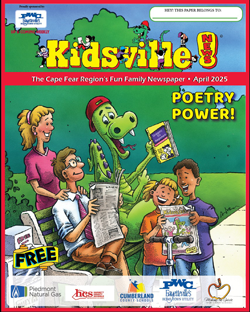 Sunday afternoon I sat through the fi nal performance of Peter Pan
at the Cape Fear Regional Theatre. It was my fi fth or sixth viewing of
the musical, and I remained as enchanted throughout the performance
as I was the first time.
Sunday afternoon I sat through the fi nal performance of Peter Pan
at the Cape Fear Regional Theatre. It was my fi fth or sixth viewing of
the musical, and I remained as enchanted throughout the performance
as I was the first time.
While there were professionals carrying three of the lead roles, the rest of the cast was rounded out with community children and high school students. As the Littlest Burton was among the cast, I had the opportunity to see how much work went into put together a production of this scale. I can tell you, it was grinding. Rehearsals started on Jan. 2 and ran all the way through to the show’s opening at the end of the month. The average rehearsal was four hours – longer in the days leading up to the opening.
Did I mention those rehearsals happened after school? These students, ages 8 and up, carried not only their school work but the grueling schedule of rehearsals as well. Some of the students were also involved in the theatre’s upcoming production of Les Miserables. They were doing double duty.
As a mother, I was very concerned about the impact of the schedule on my son’s school performance. We were, after all, doing homework on the way to the theatre and getting up early in the morning to complete what was left undone. I imagine that was the case with all of the students in the cast.
I had the opportunity to talk with Bo Thorp, the theatre’s artistic director about the subject. Thorp, who has a passion for children, noted that children involved in the arts tend to do better in school. They learn to balance their creative time with their academic time, and the time spent pursuing the arts actually makes them better students. She noted that one of the students who was pulling double duty on both plays had recently told her he made the A Honor Roll.
Her experience with the success of children in the theatre is not an anomaly. A recent Harris Poll shows a positive association of music with lifelong educational attainment and higher income. Nearly nine in ten people (88 percent) with post graduate degrees participated in music education. Further, 83 percent of those with incomes higher than $150,000 or more participated in music.
“Research confirms that music education at an early age greatly increases the likelihood that a child will grow up to seek higher education and ultimately earn a higher salary,” said Dr. John Mahlmann, executive director of MENC: The National Association for Music Education. “While music clearly corresponds to higher performing students and adults, student access to music education has dropped about 20 percent in recent years, thanks in large part to the constraints of the No Child Left Behind Act.”
Other studies show the value of music programs to our future generations:
• Students in top quality music programs scored 22 percent higher in English and 20 percent higher in math on standardized tests mandated by the No Child Left Behind Act (University of Kansas)
• In 2006, SAT takers with coursework in music performance scored 57 points higher on the verbal portion of the test and 43 points higher on the math portion (The College Board, Profi le of College-Bound Seniors National Report for 2006)
While schools across the nation are cutting music and arts programs from their daily schedule, in Cumberland County, we are blessed to have institutions like the CFRT, Snyder Music Academy, the Kidsville Kids, the Arts Council and the Fayetteville Museum of Art that work daily to bring arts education to our county’s children.
From personal experience, I know that incorporating music and the arts helps a child’s development. I’ve seen it with my own eyes. Benchmark Testing was conducted in the Cumberland County Schools during the opening week of Peter Pan. We were in rehearsal until 11 p.m. that week, and I knew my son was tired. I was really worried about his performance on the test. When scores came out this month, I was overwhelmed. My son, who is dyslexic, scored 20 percent higher than the county average in reading and held his own in math.
There is a place for music and art in our children’s
lives. It’s up to us as a community to make sure it
stays there.

 How to resolve AdBlock issue?
How to resolve AdBlock issue? 








